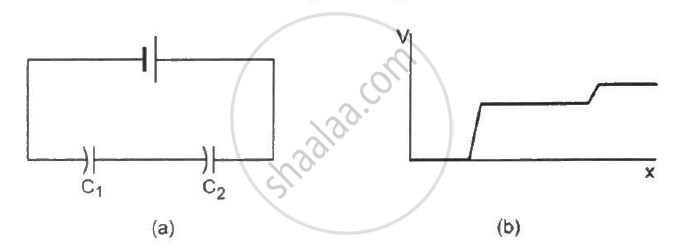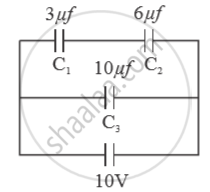Advertisements
Advertisements
प्रश्न
A parallel-plate capacitor having plate area 20 cm2 and separation between the plates 1⋅00 mm is connected to a battery of 12⋅0 V. The plates are pulled apart to increase the separation to 2⋅0 mm. (a) Calculate the charge flown through the circuit during the process. (b) How much energy is absorbed by the battery during the process? (c) Calculate the stored energy in the electric field before and after the process. (d) Using the expression for the force between the plates, find the work done by the person pulling the plates apart. (e) Show and justify that no heat is produced during this transfer of charge as the separation is increased.
उत्तर
Given :
Area, A = 20 `"cm"^2 = 2 xx 10^-3 "m"^2`
Separation , `d_1 = 1 "mm" = 10^-3 "m"`
Initial Capacitance of the capacitor ;
`C_1 = (∈_0A)/d_1`
`C_1 = (8.88 xx 10^-12 xx 20 xx 10^-4)/(1 xx 10^-3)`
`C_1 = 1.776 xx 10^-11 "F"`
Final capacitance of the capacitor :
`C_2 = C_1/2` (because `d_2 = d_1/2`)
(a) Charge flown through the circuit :
`Q = C_1V - C_2V`
`Q = (C_1 - C_2)V`
`Q = 1.776/2 xx 10^-11 xx 12.0`
`Q = 1.06 xx 10^-10 C`
(b) Energy absorbed by the battery :
`E = QV = 1.06 xx 10^-10 xx 12`
`E = 12.72 xx 10^-10 J`
(c) Energy stored before the process, `E_i = 1/2C_1V^2`
⇒ `E_i = 1/2 xx 1.776 xx 10^-11 xx (12)^2`
⇒ `E_i = 12.7 xx 10^-10 J`
Energy stored after the process, `E_f = 1/2 C_2V^2`
⇒ `E_f = 1/2 xx 1.776/2 xx 10^-11 xx (12)^2`
⇒ `E_f = 6.35 xx 10^-10 J`
(d) Work done, W = Force × Distance
= `1/2 xx (Q^2)/(∈_0A) xx 1 xx 10^(-3)`
= `1/2 xx (12 xx 12 xx ∈_0 xx ∈_0 xx 10^(-3))/(∈_0 xx 2 xx 10^(-3))`
⇒ W = 6.35 × 10−10 J
(e) Transfer of charge as the separation is increased
`ΔE = E_i - E_f`
W = 6.35 × 10−10 J
⇒ ΔE = W
APPEARS IN
संबंधित प्रश्न
Two capacitors of unknown capacitances C1 and C2 are connected first in series and then in parallel across a battery of 100 V. If the energy stored in the two combinations is 0.045 J and 0.25 J respectively, determine the value of C1 and C2. Also calculate the charge on each capacitor in parallel combination.
An electrical technician requires a capacitance of 2 µF in a circuit across a potential difference of 1 kV. A large number of 1 µF capacitors are available to him each of which can withstand a potential difference of not more than 400 V. Suggest a possible arrangement that requires the minimum number of capacitors.
Deduce an expression for equivalent capacitance C when three capacitors C1, C2 and C3 connected in parallel.
A circuit is set up by connecting inductance L = 100 mH, resistor R = 100 Ω and a capacitor of reactance 200 Ω in series. An alternating emf of \[150\sqrt{2}\] V, 500/π Hz is applies across this series combination. Calculate the power dissipated in the resistor.
Suppose a charge +Q1 is given to the positive plate and a charge −Q2 to the negative plate of a capacitor. What is the "charge on the capacitor"?
The plates of a parallel-plate capacitor are given equal positive charges. What will be the potential difference between the plates? What will be the charges on the facing surfaces and on the outer surfaces?
If the capacitors in the previous question are joined in parallel, the capacitance and the breakdown voltage of the combination will be
A parallel-plate capacitor has plates of unequal area. The larger plate is connected to the positive terminal of the battery and the smaller plate to its negative terminal. Let Q, and Q be the charges appearing on the positive and negative plates respectively.
The following figure shows two capacitors connected in series and joined to a battery. The graph shows the variation in potential as one moves from left to right on the branch containing the capacitors.

The separation between the plates of a charged parallel-plate capacitor is increased. Which of the following quantities will change?
(a) Charge on the capacitor
(b) Potential difference across the capacitor
(c) Energy of the capacitor
(d) Energy density between the plates
The plates of a capacitor are 2⋅00 cm apart. An electron-proton pair is released somewhere in the gap between the plates and it is found that the proton reaches the negative plate at the same time as the electron reaches the positive plate. At what distance from the negative plate was the pair released?
Three capacitors of capacitance `C_1 = 3muf` , `C_2 = 6muf` , `C_3 = 10muf` , are connected to a 10V battery as shown in figure 3 below :

Calculate :
(a) Equivalent capacitance.
(b) Electrostatic potential energy stored in the system
A wire of resistance 'R' is cut into 'n' equal parts. These parts are then connected in parallel with each other. The equivalent resistance of the combination is :
Three different capacitors are·connected in series. Then:-
Two charges q1 and q2 are placed at (0, 0, d) and (0, 0, – d) respectively. Find locus of points where the potential a zero.
The total charge on the system of capacitors C1 = 1 µF, C2 = 2 µF, C3 = 4 µF and C4 = 3 µF connected in parallel is ______. (Assume a battery of 20 V is connected to the combination)
The capacitors, each of 4 µF are to be connected in such a way that the effective capacitance of the combination is 6 µF. This can be achieved by connecting ______.
